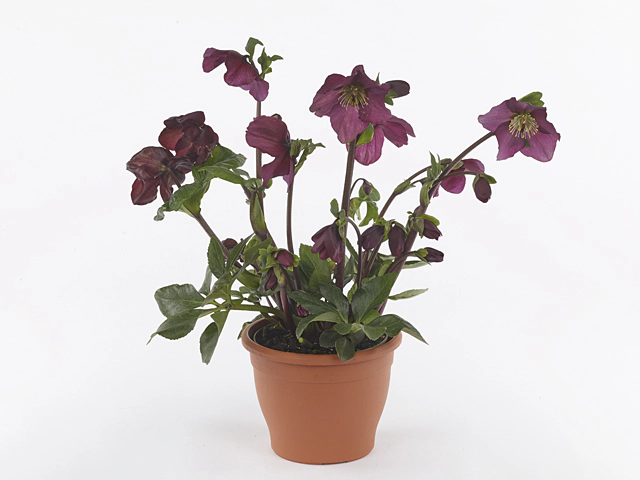Helleborus Hgc Leona

| Flower type | Single |
| Leaf margin | Serrate |
| Winter hardness | Good (USDA-zone 5, 6) |
| Flower color | Red-dark purple red-N186D |
| Flower diameter | 10 - 11 cm |
| Plant height | 30 - 40 cm; 40 - 50 cm |
| Flowering month(s) | January; February; March; December |
| Leaf size | 7,5 - 10 cm |
| soil pH requirement | Neutral (pH 6,5 - 7,5); Alkaline (pH > 7,5); Slightly acidic (pH 4,5 - 6,5) |
| Light conditions | Semi-shades |
| Leaf division | Digitate-lobed; Diversely compound |
| Leaf, main color | Dark green |
| Leaf colour, pattern | Unicolored |
| Flower color distribution | Unicolored |
| Toxicity (if consumed) | Toxic |
| Moisture requirements | Well-drained; Moist |
| Soil type | Humus rich |
The Helleborus Hgc Leona, commonly known as the Hellebore, is a beautiful flowering plant that thrives in colder climates. It is a single-flower variety with serrated leaf margins, making it a visually striking addition to any garden. This plant is known for its excellent winter hardiness, making it suitable for areas with USDA-zone 5 and 6.
One of the standout features of the Helleborus Hgc Leona is its stunning flower color. The blooms are a deep, dark purple-red shade known as N186D, which adds a touch of elegance and drama to any garden. The flower diameter ranges from 10 to 11 cm, making the blooms quite substantial and eye-catching.
In terms of plant height, the Hellebore can grow to be between 30 and 50 cm tall, depending on the specific variety. This makes it a versatile plant, as it can be used as an eye-level feature or as a ground cover in a larger garden. The Hellebore flowers during the winter months, from January to March and even into December in some cases, adding much-needed color and beauty to the winter landscape.
The leaves of the Hellebore are another noteworthy feature. They have a size of 7.5 to 10 cm and can be either digitate-lobed or diversely compound. The main color of the leaves is a dark green, which provides a striking contrast against the dark red flowers. The leaf color is unicolored, meaning it does not have any distinct patterns.
It is important to note that the Hellebore is toxic if consumed, so caution should be exercised around children and pets. However, this plant does not typically attract pests and is generally low-maintenance. It thrives in well-drained, slightly acidic to alkaline soil with a pH ranging from 4.5 to 7.5. It prefers semi-shaded light conditions, making it ideal for areas with partial shade.
Another important factor to consider when growing the Helleborus Hgc Leona is its moisture requirements. This plant thrives in well-drained soil but also tolerates moist conditions. Therefore, it is important to provide adequate drainage to prevent waterlogging, especially in areas with heavy rainfall.
Overall, the Helleborus Hgc Leona is a stunning flowering plant that brings color and beauty to winter gardens. With its deep red flowers, dark green leaves, and versatile growth habit, it is a popular choice for gardeners looking to add interest to their outdoor spaces. With the right care and attention, this plant can be a long-lasting and valuable addition to any garden.
Market availability index by month:
| Jan. | Feb. | Mar. | Apr. | May | Jun. | Jul. | Aug. | Sep. | Oct. | Nov. | Dec. |
|---|---|---|---|---|---|---|---|---|---|---|---|
| 3 | 2 | 1 | - | - | - | 1 | 1 | 1 | 3 | 4 | 3 |